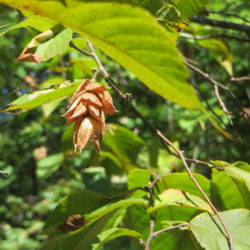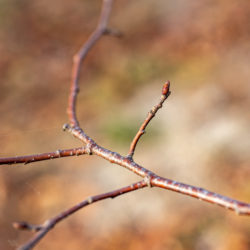Etymology
Ostrya is the Greek name for this tree; virginiana is the New Latin term meaning “of Virginia.”
Native Habitat
Forests, woodlands, talus and rocky slopes
Garden Uses
Ironwood can be used as a lawn tree, street tree or in a woodland garden.
Overview
American hop hornbeam is a deciduous native tree, which usually occurs in dry soils on rocky slopes, upland woods and bluffs. It is a small to medium-sized, understory tree with a generally rounded crown. The tree is short-lived and typically grows 25 - 40' tall with a slightly smaller spread. It thrives in average, medium, well-drained soil in full sun to part shade.
Leaves and Stems
This tree features birch-like leaves that are simple and alternate. They are soft to the touch, oval-elliptic in shape, 2 to 5 inches long, 1 to 2 inches wide, sharply double-toothed along the edges, and tapered to a pointed tip. The base of the leaf is rounded and symmetrical. The upper surface is dark green with fine, velvety hairs, lower surface lighter green, and with tufts of hairs in the vein axils. The leaves turn an undistinguished yellow in autumn and often drop early, although it typically retains a number of dried brown leaves through the winter months. The twigs are red or brown and the bark is ridged or plated and hangs or peels off of adult trees. While most often it has only a single trunk, it’s not uncommon to find multi-trunked specimens. Trunks can reach 14” in diameter.
Flowers
The tree is monoecious with reddish-brown male flowers and greenish female flowers appearing in separate catkins on the same tree. Flowers are not particularly showy, although the male catkins are more prominent and are present throughout winter. Male catkins are in groups of 1 to 4 from the tips of 1-year-old branchlets, ¾ to 2¼ inch long. Female catkins are 1/8 to ½ inch long at the tips of first year branchlets.
Fruit/Seed
Female catkins are followed by showy, drooping clusters of sac-like, seed-bearing pods which, as the common name suggests, somewhat resemble the fruit of hops. The fruit is a small, oval nutlet enclosed in an inflated, papery sac 1/3 to 1 inch long and can be harvested when the pods turn brown in mid September.
Wildlife Associates
The buds and nuts are eaten by a wide variety of birds, including grouse, bobwhite and pheasant.
Propagation
Collect seeds and and sow immediately or spread in shallow layers to dry. Cold stratification is the best means of storing over winter if planting in the spring.
Ethnobotanical Uses
The wood of this tree was was used for runners on sleighs. It is now often used to make fence posts and tool handles. The inner wood was used to treat toothache, sore muscles, and coughs by Native Americans.
Garden Location
Entry Garden (see garden map)
Anecdotal Information
Hop hornbeam gets one of its common names from its fruits, which are enclosed in scales that loosely resemble the hops used in making beer. It gets its other common name, Ironwood, from its dense tough wood that is very hard to saw.
Sources
Restoring The Landscape With Native Plants
Lady Bird Johnson Wildflower Center
Plant Profile by Kathy Kling


